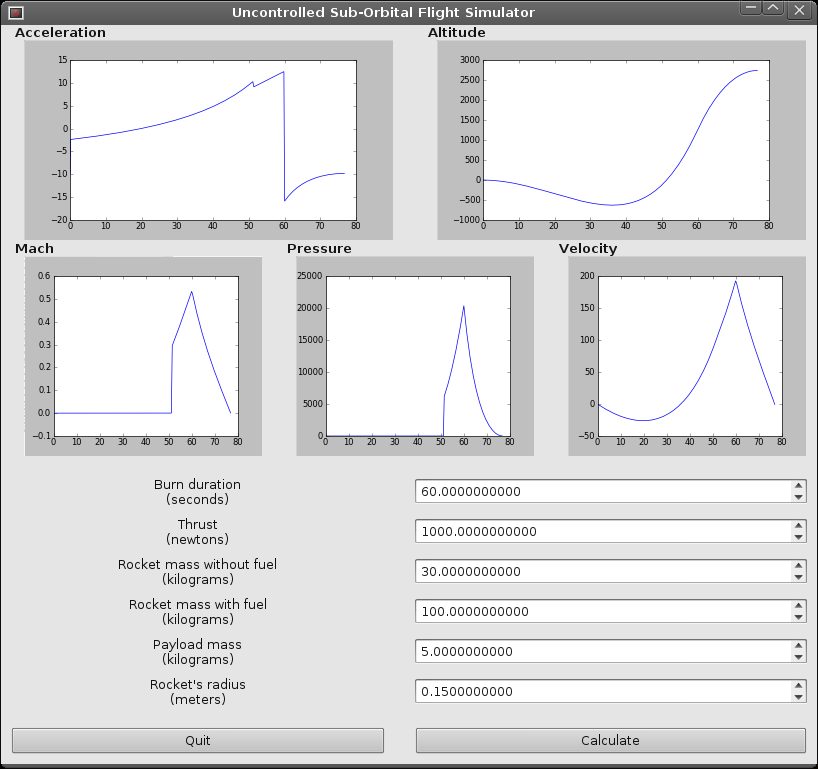Since appearing on spacehack.org, we've had a nice influx of new members, a few of whom are software people and have expressed an interest in helping to improve the currently quite basic USOFS software. This thread is supposed to be a place where (i) I can present these new people with the information they need to start working on USOFS and (ii) the entire community can throw around ideas on what sort of improvements/features USOFS could really stand to have.
First things first: What is USOFS? USOFS, or Uncontrolled SubOrbital Flight Simulator, is a program for simulating the trajectories of uncontrolled rockets on suborbital trajectories (i.e. trajectories with maximum altitudes exceeding 100km, hence "in space", but with maximum velocities too low to achieve orbit). It is primarily intended to help plan the construction of the OHKLA rocket. It's fairly simple, conceptually: the underlying physics model includes simply gravity (which is modelled as constant across altitudes), a constant acceleration from the rocket engine, and drag computed according to the standard drag equation. The equations of motion are solved numerically using a 4th order Runge Kutta algorithm.
So: Where is USOFS? It's in the Mercurial repository of the CSTART Google Code Project. You can view the trunk source code in your web browser. It's written in Python (2.x).
How can you work on USOFS? The standard procedure is for you to create a clone of the Mercurial repository. This is a complete duplicated of the official repository which you can work on however you like without any kind of fear of breaking anything, like your own personal sandbox. You can do so from this page by using the link under the "Create your own clone" header – note that you must be signed into a Google account to do so. Once you've got something that you think is good committed to your clone (if you're new to Mercurial and need help using it, check out this tutorial or just Google around), you can contact anyone who has committer access to the official repository (currently myself, brmj and rpulkrabek) and ask us to have a look at your work (in the case of USOFS I am probably the best person to contact). If it's good, one of us will merge your work into the main repository. If you make a few good contributions to the repository in this manner and you seem generally trustworthy, you'll eventually be offered committer access yourself.
What sort of stuff would it be useful for you to do on USOFS? Some preliminary ideas:
- GUIfication. Currently USOFS is command line only. While I think it would be good to maintain the ability to run it from the command line, a GUI option as well would be handy. This shouldn't be too hard, it is mainly just a case of giving the user a way to enter some numerical values and then having some "go" buttons and a nice way to present the data. This last part leads into…
- Graph generation. Currently USOFS spits out big text files full of figures in a CSV format. I have been using the gnuplot program to create graphs so far. It would be very nice if USOFS could generate its own graphs (displaying them onscreen when running in GUI mode and saving them to a .png file when running in command line mode). The matplotlib library for Python seems like the obvious solution to this.
- Different thrust profiles. Currently USOFS makes the fairly inaccurate assumption that the rocket engine produces constant thrust for the entire duration of its burn. While we should keep this option as a fall back, it would be good if we could have people specify different profiles, e.g. a linearly decreasing thrust from some initial maximum to some final minimum, exponentially decaying thrust, etc. This is the one proposed modification so far which would require an actual understanding of how the physics code works, not just the interface it presents. I'm happy to advise anybody who wants to tackle this problem on how to go about making these changes.
- Better supersonic drag simulation: this would require somebody with more knowledge than the current CSTART team seems to have collectively about aerodynamics. If you are such a person or know such a person, please speak up.
I realise this has been written fairly briefly and there is probably a lot to absorb in a short time. If anybody has any specific further questions, please ask and I will do my best to clear them up to the point that you can do some work
We're very keen to see some progress made on this front, so if anything is troubling you please speak up and we will try our best to accommodate you. If you can't or don't want to figure out how to work Mercurial, we can work something out where you just email .py files to someone and they'll put them in the repository for you or something like that.

 ) so the same variable names are currently used in the GUI labels, these could do with being changed to something more descriptive by someone who knows what they are.
) so the same variable names are currently used in the GUI labels, these could do with being changed to something more descriptive by someone who knows what they are.